Slavery started in Haiti with the arrival of Columbus. Met with friendliness, welcoming gifts, and delicious local fritters called Accra or Akra, he described the native Arawak Taino people as “tractable, and easily led; they could be made to grow crops and build cities” (Mellzer, Slavery: A World History, 1971). And the gentle, helpful natives were forced to do just that, as well as work in the gold and copper mines. Nobody knows how many Taino people had lived on the island before Columbus “discovered” them – nobody bothered counting! – but about a third of the population died of hard labor and European diseases within the first two years, and estimated 92% disappeared during the first ten years (Thomas, The Slave Trade: The Story of the Atlantic Slave Trade: 1440–1870, 2013).

Don Diego Columbus, the 2nd Admiral of the Indies, 2nd Viceroy of the Indies and 4th Governor of the Indies “by right of his father’s discovery” (as well as by dint of being married to King Ferdinand’s second cousin – nepotism works!) was forced to bring the African slaves to the island in 1505 due to the drastic decimation of Taino population. “Someone had to work the plantations, after all,” – he reasoned.

It marked the beginning of three hundred years of brutality the likes of which is hard to find anywhere else. No wonder slave uprising were frequent! Thousands of slaves escaped into the mountains, forming communities called maroon (reddish-brown color). Their knowledge of native plants afforded a unique weapon of resistance – poison. Fear of being poisoned spread among plantation owners like wildfire, prompting the French King to issue a ban on poisoning. The maroons’ reaction was to use another tactic – arson. Having been used by the gentle Tainos to prepare feasts of welcome, fires now burned bright, consuming slaveholders together with their livestock and properties. Eventually, the flame of resistance culminated in a successful revolution (1791 – 1804), the first and the only such event in the world that gave birth to an independent nation.
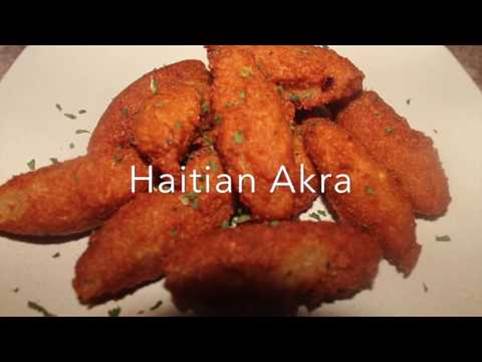
he same delicious fritters probably made for Columbus by the hospitable Taino natives are still popular in Haiti, and my student Rose Andrelle Pierre kindly shared this recipe and photos.
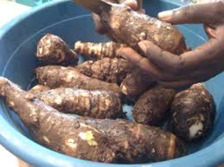
It is really so simple that you start wondering how something so simple could be so good! You need about 8 – 10 malanga roots, and you peel them the way you peel any root vegetable. An important fact about malanga, AKA yauta, is that it is nightshade and gluten free. Grate your malanga on a fine grater and put it aside.



The secret of Accra is in seasoning: green pepper, hot peppers, lots of garlic, scallions, parsley, and some bouillon cubes or soup powder. Haitians prefer Maggi brand, but any soup powder will add the right flavor (note: Maggi is not kosher). Add some salt and hot sauce, if you are so inclined, and apply elbow grease to pound it into paste with your mortar and pestle. What – you don’t have a mortar and pestle? Don’t worry, says Andrelle, you obtain the same results by using your trusty blender.
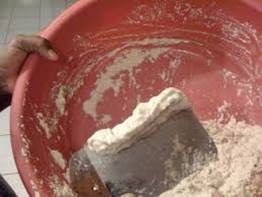
Mix the seasoning paste with grated malanga, and you are ready to fry.
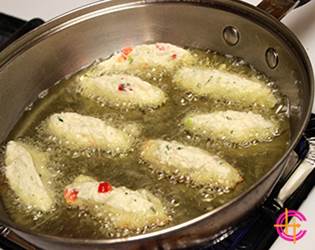
Remember plantation fires preceding the slave revolution, and start your deep frying on high flame. Form those oval beauties, drop them into boiling oil, and reduce heat to medium. It only takes about 3 – 4 minutes for them to acquire that gorgeous maroon color – reddish brown.
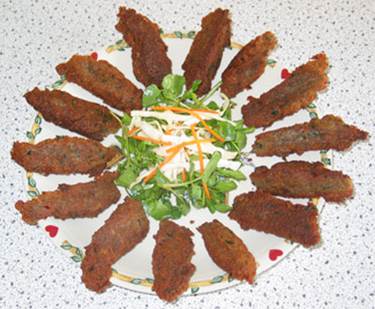
Serve your Accra with vegetables as an appetizer or a snack, or use it as a side dish to complement Haitian Baked Fish (Haiti, Part 1). Andrelle wishes you Bon Appetite!
INGREDIENTS
8 – 10 malanga roots
1/2 diced green pepper
3 – 4 garlic cloves
1 scallion
3 hot peppers
Small bunch of fresh parsley
1 1/2 bouillon cubes or heaping tablespoon of pareve soup powder
Salt and hot sauce to taste
PROCEDURE
Peel and finely grate malanga.
Blend the rest of ingredients into smooth paste. Add to grated malanga, mix thoroughly.
Heat oil in deep frying pan, form oval fritters, drop into boiling oil, reduce to medium heat. Fry for 3 – 4 minutes or until reddish-brown.
Remove to dish lined with paper towel to blot out excess oil.
Serve with green vegetables.
Enjoy!

My knowledge of Haiti increases with each of your posts
LikeLiked by 2 people
Thank you, Derrick. It is a fascinating little country with rich history and unique culture, and I am not even touching voodoo, which is still a deeply ingrained belief.
LikeLiked by 2 people
This seems easy to make Dolly and it looks delicious 😀
I don’t know, if I can find Malanga here, but I will try.
LikeLiked by 1 person
Thank you, dear Irene. I guess you can substitute parsnips if you can’t get malanga.
LikeLiked by 1 person
Okay and thank you for the suggestion, Dolly 🙂
LikeLiked by 1 person
My pleasure!
LikeLiked by 1 person
You put so much work in these posts, Dolly. I’m just now catching up after weeks of guests and Xmas and NY celebrations..
LikeLiked by 1 person
Thank you, Judy; it’s the labor of love – I am having fun doing it. I am also catching up after Chanukkah and all kinds of tech issues.
LikeLiked by 1 person
Sounds very very delicious. Thank you, Dolly!
LikeLiked by 1 person
Thank you so much, dear friend!
LikeLiked by 1 person
Thank you too, Dolly! You are the presenter and the greatest teacher too. Best wishes, Michael
LikeLiked by 1 person
You are too kind, Michael! Have a great weekend.
LikeLike
Blending the palate with a history lesson and wanderlust…
~B
LikeLiked by 1 person
Thank you, dear Beaton.
LikeLiked by 1 person
Reblogged this on koolkosherkitchen and commented:
We continue with my Haiti series by repeating a traditional Haitian snack cum side dish. Enjoy, Beautiful People!
LikeLike
An interesting post today! I hadn’t heard of this plant, so looked it up. Duck weed, Philodendrun, and Dieffenbachia are in the same family (Arum), yet I can’t imagine eating any part of them! The source also indicated it grows in Florida as an invasive plant.
LikeLiked by 1 person
Malanga is also known as Japanese potato or yarrow root. https://www.healthline.com/health/malanga
It does grow all over the place here, and people sell it for pennies from the back of their trucks on every intersection.
LikeLike
Yarrow I’d heard about, though I couldn’t have told you what it is. That was a very interesting post!
LikeLike
Thank you so much, Doug. Because of my husband’s diet, we can’t have it any more, but I used to make all kinds of delicious Caribbean dishes with malanga. We live in the midst of Latin American and Caribbean cultures, and as a curious cat, I had to try everything.
LikeLiked by 1 person
Availability of the ingredients there makes a big difference, too, I bet!
LikeLiked by 1 person
You are right, even though my favorite farm market closed at the very beginning of Covid. Still, even supermarkets here offer much more in terms of seasonal tropical produce than in colder climes.
LikeLike
It is amazing the Asian and Mexican specialties that are available even in a small town like mine. It used to be very rare that you’d find anything more exotic than faux Chinese chow mein in cans or canned tamales.
LikeLiked by 1 person
Sounds great; you can have some variety on your table. Happy New Year to you and dear Andy, and may 2021 bring only health and happiness!
LikeLike
I like to try these specialties, especially after I see how they have been used on food programs.
LikeLiked by 1 person
Enjoy!
LikeLike
Thanks!
LikeLiked by 1 person
My pleasure.
LikeLiked by 1 person
As a cousin of the Malanga, I guess I could use taro they look and sound very tasty dear Dolly and coupled with some colourful history a perfect recipe 🙂 x
LikeLiked by 1 person
Yes you can use taro, dear Carol, and I thank you very much for a lovely comment.
Happy, healthy, and safe 2021 to you and yours!
LikeLiked by 1 person